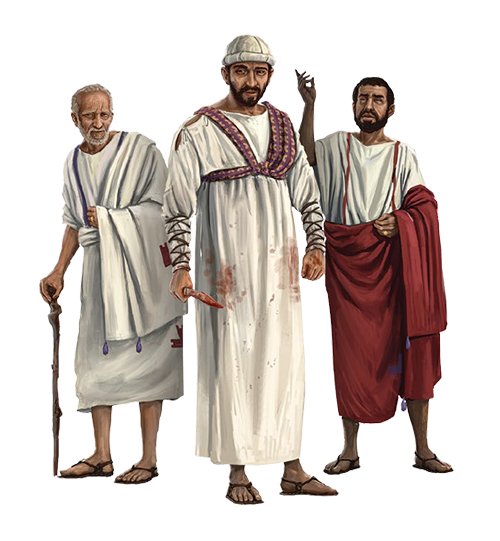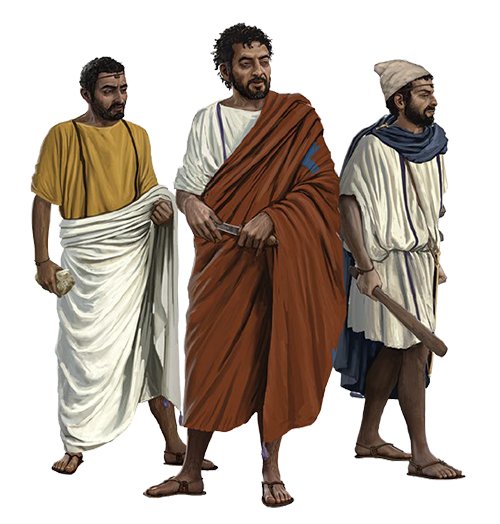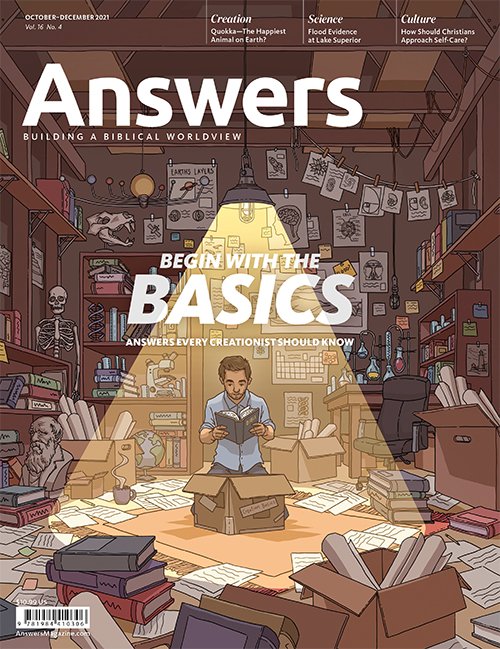Life in the Borderland
While researching for the Creation Museum’s newest exhibit, the content writer discovered surprising parallels between life at the time of Christ and the culture today.
The Old Testament closes with the Jewish people back in their land following a 70-year exile in Babylon. The Temple and walls of Jerusalem have been rebuilt, but the situation is bleak. God remains silent over the next 400 years while Israel languishes under Persian, Greek, and Roman authorities.
As the New Testament opens, the Jewish people have divided into philosophical, religious, and political factions. Greek language and ideas permeate society, but the Roman Empire rules the Mediterranean world. Yet an Idumaean king raised as a Jew sits on the throne in Jerusalem.
Three centuries before the birth of Jesus, the armies of Alexander the Great sweep eastward from Greece to India. His conquests bring new forms of government, education, and religious practice. This spreading of Greek culture—called Hellenization—challenges nearly every aspect of Jewish life.
Some Jews readily embrace Hellenism while others resist the changes. Then, God breaks his silence and sends his son into this borderland to be born of a virgin. Nothing will ever be the same.
—From Borderland: Israel in the Time of Jesus, a new Creation Museum exhibit
The Creation Museum—a ministry of Answers in Genesis, which also publishes this magazine—unveiled a spectacular new exhibit on July 6, 2021. Filled with more than 35 original art pieces, accurate reconstructions of armor and clothing, and dozens of lifelike miniature figures, Borderland: Israel in the Time of Jesus offers guests an immersive look into the historical and cultural backdrop of the New Testament.
The Borderland exhibit contains more content than any other Creation Museum exhibit. As the content manager at our attractions, my primary role is to either write or oversee the writing of the content for exhibits at the Ark Encounter and Creation Museum. Our exhibits typically follow a narrative: every sign emphasizes a single point and logically leads to the next sign. But Borderland is different in that it focuses on a variety of topics relevant to studying the background of the New Testament. Beginning with Alexander the Great’s conquests, moving through the four tumultuous centuries prior to the birth of Christ, and concluding with the destruction of Jerusalem in AD 70, topics ranged from warfare and weaponry to daily life and clothing styles to the people and historical events that shaped the world where Jesus walked. Instead of researching one particular topic in detail and then writing about it at length, this exhibit required us to investigate scores of topics before summarizing each one in a brief paragraph or two.
While I immersed myself in the culture of first century Israel, I realized that it somehow seemed quite familiar. That little borderland has many lessons for the landscape Christians find themselves in today. I often noticed that, regardless of century or culture, people tend to respond in predictable ways to cultural pressures. But I was also reminded that the answer to tumult in our world remains the same.

Gentiles were not permitted into the Temple beyond the Court of the Gentiles. In the early days of the church, believers frequently gathered at the Temple to pray and teach.
Greek Influence
Consider how the Jewish people responded in the following situations. When the Seleucid Empire ruled Israel (second century BC), Greek religious and philosophical ideas rapidly permeated much of Jewish society. Many upper-class citizens adopted Greek customs and practices, compromising the faith of their fathers that had been handed down generation after generation, as recorded in the Old Testament. Some used political intrigue to gain power. A man named Jason purchased the high priesthood and sought to turn Jerusalem into a Greek city. His successor, Menelaus, bribed Antiochus IV Epiphanes for the office and attempted to institute radical Hellenistic practices in the temple. Many Jews who lived outside Jerusalem resisted these changes and sought to live out their faith as commanded by the Lord through Moses and were persecuted by their own people or killed by the Greeks.
Pushed to the breaking point, some Jews resorted to violence against their oppressors. A priest named Mattathias refused to offer a pagan sacrifice and ended up killing a Seleucid official and a compromising Jew who volunteered to perform the sacrifice. This event sparked the Maccabean Revolt that eventually led to a semi-independent nation before Rome assumed total control.
Roman Rule
The same types of behaviors occurred when Rome ruled Israel. Some Jews compromised their faith either to avoid persecution or gain political power. Though little is known about them, the Sadducees were apparently an upper-class religious sect concerned much more with political power than theological correctness. Rulers like Herod the Great embraced corruption, currying favor with Rome by heavily taxing his own people and erecting monumental structures dedicated to Caesar and Roman gods.
Many Jews, particularly those in rural areas, sought to obey the Lord’s commands for Israel but often faced persecution for their stance. The Pharisees took this mindset to an extreme level, emphasizing a rigid adherence to the Torah and to the traditions they had developed. Others, like those in the Qumran community, attempted to withdraw from society. In the few decades after Christ’s ministry, a small minority of Israelites known as Sicarii sought to overthrow Rome and initiate their concept of a Jewish kingdom by force, resorting to acts of terrorism in the streets and twisting Scriptures to justify their murderous actions.

As the capital city, Jerusalem housed the nation’s political and religious authorities. The Jewish Temple and the adjacent Roman Antonia Fortress symbolized the uncomfortable tension between the Jewish people and the occupying Romans.
Changing Yet Staying the Same
The old adage seems to fit: the more things change, the more they stay the same. Think about how Christians in the Western world have responded to recent secular and pagan pressures of the culture. Like the Sadducees before them, scores of Christian leaders have renounced biblical doctrines. Well-known pastors, authors, and musicians have compromised on creation, eternal punishment, sexuality, gender, the sanctity of life, or other unpopular biblical teachings because of our culture’s shifting positions on these issues. Sadly, some have gone so far as to deny the Christian faith altogether and join the secularists in mocking and persecuting Christians who simply seek to live as Christ and the apostles taught—loving God, loving their neighbors, and making disciples. Some professing Christians seek to change the culture through political efforts, but as so often happens in politics, the love of money and power leads to corruption and compromise.
Rather than yielding to the culture, some Christians emphasize a rigid adherence to the faith, and like the Pharisees, they elevate some of their own traditions to the level of dogma. It is not uncommon for them to attack fellow believers who do not share their approach. Like the Qumran community who lived near the wilderness, some believers today seek to withdraw from culture. And some individuals lash out violently against perpetrators of ungodly practices.
What can we learn from this period about how to properly respond to societal pressures? As always, Christians should look to the example of Jesus Christ. During his ministry in Israel, he interacted with people who fit into many of these categories: cunning politicians, compromising religionists, hypocritical legalists, forceful revolutionaries, and sincere followers of God.
When the Sadducees ridiculed the doctrine of a future resurrection, Jesus did not cave to societal pressures. Instead, he stood against their compromise and emphasized an Old Testament passage that clearly implied life after death (Matthew 22:32). When the Pharisees complained that the disciples failed to properly wash their hands before eating, Jesus condemned the legalistic traditions that led the Pharisees to ignore God’s Word (Matthew 15:3–9). When the crowds sought a political solution to their situation and wanted to make him the king (John 6:15), Jesus departed because he knew the time was not right and that God’s plan—that Jesus would die a terrible death to bear the penalty of our sins (John 3:16–17)—would come to pass in accordance with his Word.

Jesus launched his ministry in Capernaum, which is on the Sea of Galilee.
How We Should Live
Jesus did not instruct his followers to resort to violence when difficult times came. In fact, he told Peter to sheath his sword (John 18:11) when the soldiers and officers came to arrest Jesus in the garden of Gethsemane. He did not encourage them to seek only political solutions, to withdraw completely from society, or to abandon the faith when faced with cultural pressures. That’s not to say that there is not a time and place for Christians to defend themselves, engage in just war, or enter politics. But we cannot look to those activities as the primary solutions to our culture’s woes. Sin is at the core of our problems as people continue in rebellion against our Creator.
Jesus came to earth to be the solution. His sacrificial death on the cross and subsequent resurrection has the power to change lives for all eternity. Rather than trusting in our own schemes or seeking the praise of men, we need to fully trust in God and his Word at all times, just as Jesus did. To properly respond in our own tumultuous culture, we must follow the example of our Lord and Savior Jesus Christ.
Spectrum of Beliefs
A traveler in first century Israel would encounter a wide range of beliefs held by people from a variety of backgrounds. While the Jewish people were generally united in their belief in one God and that they were his special people who were promised an everlasting kingdom, they clashed over how and when that kingdom would be established. Do you recognize these groups from Scripture?

Jewish Christians
The earliest converts to Christianity were Jews who came to believe that Jesus of Nazareth truly was their Messiah and King. Early on, these new believers met in the Temple, but growing tension with Jews who rejected Jesus eventually led to their expulsion from the Temple and synagogues.

Pharisees
Commonly considered to be legalists, the Pharisees were a large Jewish sect known for their expertise in and rigid adherence to the Law and traditions. They emphasized holiness and ritual purity, which they believed came through obedience to the Law and traditions. Many strongly opposed the Messianic claims of Jesus.

Sadducees
Little is known about these individuals who are mentioned 14 times in the New Testament, which reveals that they rejected belief in the future resurrection, as well as belief in the spirit and angels (Acts 23:8). Because none of their writings have survived, they are known only from sources who were at odds with them. They seem to have been an upperclass religious sect closely connected to the high priesthood who were more concerned with keeping political power than theological correctness.

Zealots/Sicarii
Frustrated by Rome’s abuse of Jewish citizens and pilfering of the Temple treasury, many of the lower priests fought back to retake the Temple and gain political power in the AD 60s. These Zealots sought to overthrow compromising religious leaders and pushed for war with Rome. Meanwhile, the Sicarii engaged in stealth violence by assassinating individuals in large crowds and then sneaking away by blending in.
Visit Borderland: Israel in the Time of Jesus, a new exhibit now open at the Creation Museum in Northern Kentucky. In this stunning exhibit, you can learn about first-century Israel through artifacts, videos, dioramas, full-scale models, signage, and more.
Answers Magazine
October–December 2021
Curious about creation but don’t know where to start? Let’s begin with the basics.
Browse Issue SubscribeRecommended Resources

Answers in Genesis is an apologetics ministry, dedicated to helping Christians defend their faith and proclaim the good news of Jesus Christ.
- Customer Service 800.778.3390
- © 2024 Answers in Genesis







